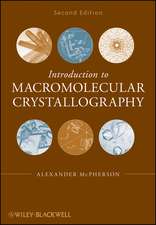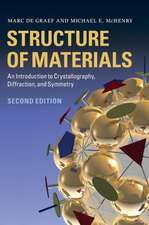Crystal Identification with the Polarizing Microscope
Autor R.E. Stoiber, S.A. Morseen Limba Engleză Paperback – 30 aug 1994
Preț: 952.89 lei
Preț vechi: 1162.06 lei
-18% Nou
Puncte Express: 1429
Preț estimativ în valută:
182.34€ • 190.85$ • 151.76£
182.34€ • 190.85$ • 151.76£
Carte tipărită la comandă
Livrare economică 31 martie-14 aprilie
Preluare comenzi: 021 569.72.76
Specificații
ISBN-13: 9780412048319
ISBN-10: 0412048310
Pagini: 288
Ilustrații: 288 p. 18 illus., 2 illus. in color.
Dimensiuni: 178 x 254 x 20 mm
Greutate: 0.66 kg
Ediția:Softcover reprint of the original 1st ed. 1994
Editura: Springer Us
Colecția Springer
Locul publicării:New York, NY, United States
ISBN-10: 0412048310
Pagini: 288
Ilustrații: 288 p. 18 illus., 2 illus. in color.
Dimensiuni: 178 x 254 x 20 mm
Greutate: 0.66 kg
Ediția:Softcover reprint of the original 1st ed. 1994
Editura: Springer Us
Colecția Springer
Locul publicării:New York, NY, United States
Public țintă
ResearchDescriere
Some of the simpler measurements of optical mineralogy are so precise and powerful that they give satisfaction to beginning students. Not long after mastering the strike and dip of rock surfaces with the Brunton compass, many geology students are able to determine precisely the identity of quartz, or the anorthite content of plagioclase, or the magne sium ratio of pyroxene with the polarizing or petrographic microscope, by means of measuring refractive index to better than one part in a thousand. Very little training and almost no theory are needed to achieve these skills. But there inevitably comes a time when theory is needed, either to get on with the art, or simply to reconstruct from first principles what is going on, when rote memory fails. In this book we hope to provide both the rote methods and the theoretical background for practitioners at all levels of experience. We draw from several careers-ours, our colleagues', and our students' -in teaching the subject at various levels of sophistication. Our book is intended to serve the needs of industrial and forensic scientists as well as petrogra phers who deal with rocks. Much of our treatment is based on new research, both in matters of presentation and in the optical determination of minerals and other materials.
Cuprins
List of symbols. Preface. Efficient use of this book. Crystal identification and optical principles. Equipment and preparation of materials. The immersion method. Isotropic crystal identification. Phase relationships and interference. Anisotropic crystals. Uniaxial crystal optics. Uniaxial interference figures. Identification of uniaxial crystals. Biaxial crystal optics. Biaxial interference figures. Identification of biaxial crystals. Crystallographic relations of biaxial crystals. Optic orientation in stereo. Special orientation methods. Use of the dispersion method. Crystal identification practicum; Appendix A: optical properties of common rock-forming minerals. Appendix B: identification of fibrous asbestos; References. Index.














